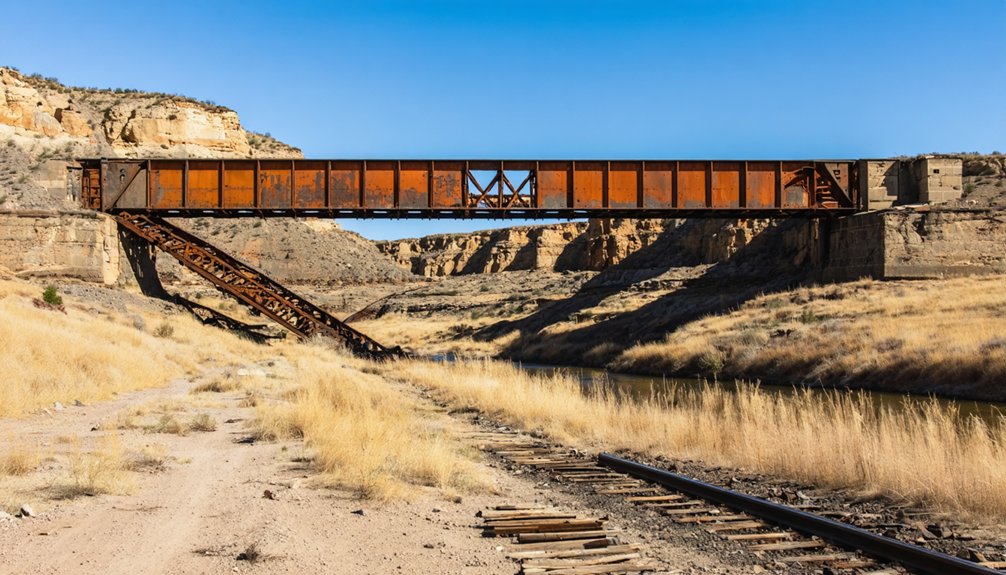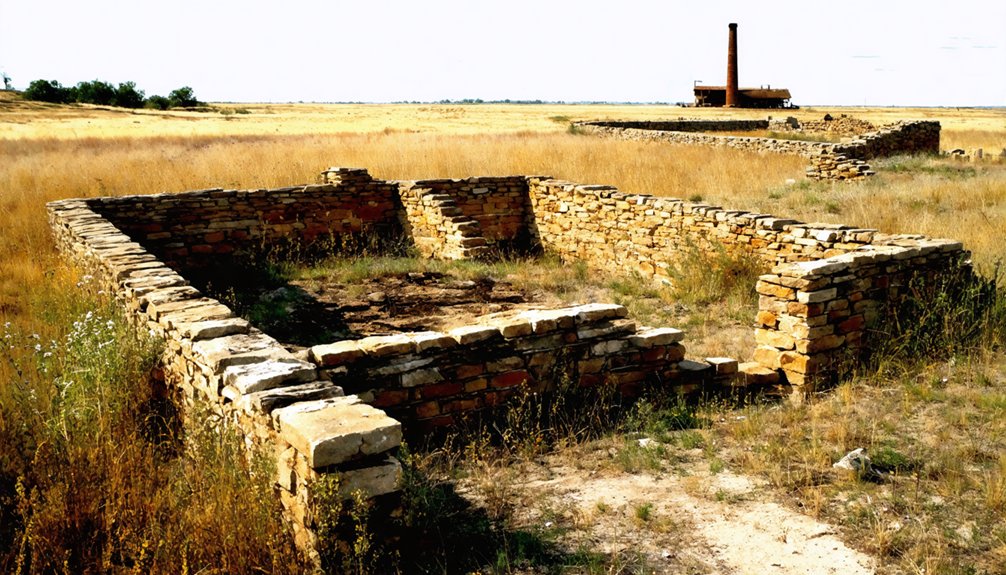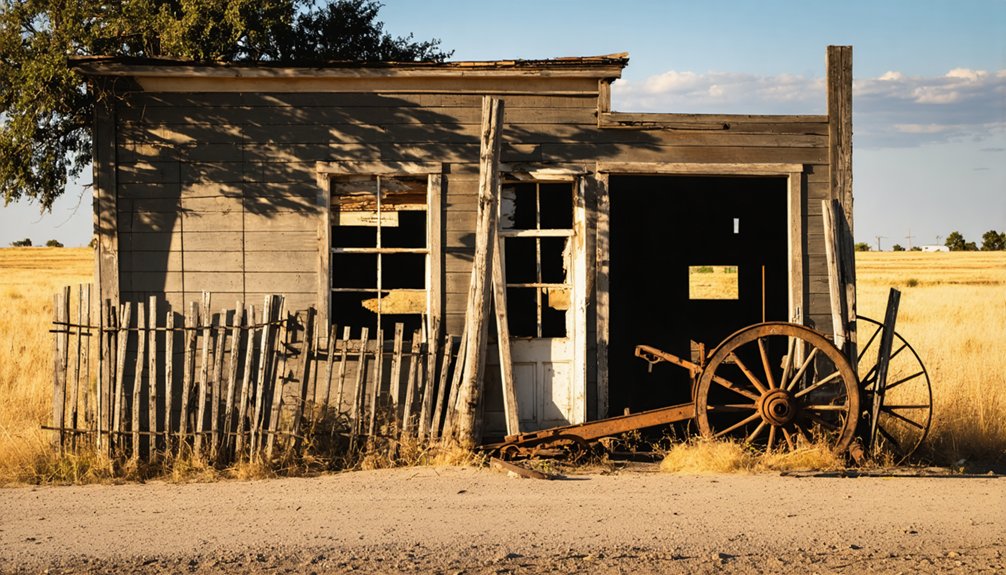You’ll find Red River Station‘s ghostly remains along Texas’s northern border, where it served as an essential Texas Rangers’ outpost established in 1861. As the main gateway to the Chisholm Trail, this bustling frontier town saw over 600,000 cattle cross the Red River at its peak in 1871. While natural disasters and railroad bypasses led to its abandonment, the site’s rich legacy as a cattle drive boomtown holds countless untold stories of the American frontier.
Key Takeaways
- Red River Station was established in 1861 as a strategic Texas Rangers outpost at a natural crossing point on Salt Creek.
- The settlement became the primary crossing point for the Chisholm Trail, processing up to 75,000 cattle during peak seasons.
- Natural disasters, including an 1891 flood and 1979 tornado outbreak, contributed significantly to the town’s eventual abandonment.
- The town’s decline accelerated when the Gainesville, Henrietta and Western Railway bypassed the settlement, diminishing its economic importance.
- Today, Red River Station exists as a ghost town, preserving its legacy as a crucial frontier outpost in Texas history.
Origins as a Texas Rangers’ Frontier Post
While Native Americans had long used the natural crossing where Salt Creek met the Red River, Red River Station emerged as a strategic Texas Rangers’ outpost in 1861.
You’ll find its origins traced to a distinctive river bend where buffalo herds once crossed, making it a natural choice for frontier defense.
Though settlers like the Graysons, Cardwells, Borens, and Quillans attempted to establish homes there by 1860, they faced fierce resistance from raiding tribes.
Early pioneers braved hostile conditions as they sought to build homes, facing constant threats from Native American raids.
The Texas Rangers responded by dispatching Captain Brunson’s company to establish Camp Brunson in late 1861.
This defensive post, later known as Red River Station, provided essential protection for about 50 pioneer families who’d seek refuge behind its stockade walls during periods of increased Indian raids.
Like other frontier Rangers of the era, the soldiers were tasked with tracking down thieves and maintaining order in the lawless territory.
Captain John Rowland assumed command in December 1862, maintaining detailed records of the company’s activities and personnel.
Gateway to the Chisholm Trail
At Red River Station, you’ll find the vital gateway where the Chisholm Trail crossed from Texas into Indian Territory, marking the last stop before drovers faced the challenging river passage north.
After the Civil War, Confederate troops who had previously been stationed at the crossing helped establish it as a key waypoint for cattle drives.
As the trail’s primary crossing point by 1870, this location funneled an estimated 60,000 to 75,000 cattle during peak drive seasons, concentrating massive herds along the river’s southern banks.
The strategic crossing allowed cattle valued at just $2 per head in Texas to reach northern markets where they’d fetch up to $40, making Red River Station an essential economic hub in the post-Civil War cattle trade. Jesse Chisholm, the trail’s namesake of Cherokee and Scottish descent, was among the first to drive cattle along this crucial route.
Strategic River Crossing Point
The natural geography of Red River Station made it an ideal crossing point where the river’s distinctive bend pushed the current against the southern bank, creating a shallow ford.
You’ll find this strategic location was no accident – for centuries before European settlement, Indigenous navigation took advantage of the river’s unique characteristics, with buffalo herds and Native American tribes establishing essential cultural exchanges at this natural crossing.
The river’s curve slowed the rushing waters, while convenient sandbars created natural stepping stones across the channel.
You’re looking at a crossing point so perfectly situated that it became the primary ford for virtually every cattle drive heading north on the Chisholm Trail. This ford became famously congested when a herd of 60,000 caused a massive traffic jam during flooding in the 1870s.
Even during high water, the geography provided safer passage than anywhere else along this stretch of the Red River.
Cattle Drive Hub
Red River Station emerged as an essential gateway to the Chisholm Trail between 1867 and 1887, serving as the last major supply point before drovers faced their grueling 350-mile journey to Abilene, Kansas.
You’d find cattle drive logistics centered around the station’s ferry service, which helped countless herds cross the Red River’s challenging waters.
If you’d visited during the peak cattle drive era, you’d have witnessed millions of cattle moving through this crucial hub.
A typical cattle drive would take six to eight weeks to complete the journey from Texas through Indian Territory to Kansas.
The Trail Drivers Association officially recognized this crossing point as the main entrance to the Chisholm Trail.
Drover experiences were shaped by the station’s strategic location at the river’s bend, where they’d stock up on final provisions before heading into Indian Territory.
The bustling settlement offered everything you’d need for the arduous trek north, from basic supplies to services that supported the continuous flow of cattle, drovers, and settlers along the famous trail.
Drovers’ Last Texas Stop
Life for cattle drovers changed dramatically once they reached this essential frontier gateway, marking their final Texas stop before embarking north into Indian Territory.
At Red River Station, you’d find yourself at a critical supply point where drovers stocked up on provisions before tackling the 350-mile push to Abilene, Kansas. You’d join thousands of others at this strategic crossing, where the river’s natural bend created favorable conditions for moving massive herds across.
The station offered everything a drover needed – a trading post, ferry service, and safe haven. This key location allowed ranchers to transport their Texas longhorn cattle breeds north toward profitable markets.
You’d share the crossing with up to 10,000 cattle per drive, maneuvering sandbars and swift waters at this historic junction. For twenty years, this gateway served as the vital shift point between Texas and the untamed expanse of Indian Territory ahead.
Life in a Cattle Drive Boomtown
As you’d walk through Red River Station during its cattle drive heyday, you’d witness thousands of cattle awaiting crossing while drovers restocked supplies and rested at the last major Texas stop before Kansas.
At the bustling supply point, cowboys mingled with merchants, livestock inspectors from the Southwestern Cattle Raisers’ Association monitored herds, and the post office handled vital communications between ranchers and their northern buyers. The dangerous river conditions meant cowboys had to construct straw bridges to safely transport their herds across. During peak drive seasons, an estimated thirty thousand cattle would congregate in the vicinity waiting for safe river crossing conditions.
You’d find yourself in the midst of a typical frontier boomtown where trail crews of 2,500-3,000 head herds traded stories at temporary camps while preparing for the challenging Red River crossing ahead.
Bustling Trail Crossing Life
During peak cattle drive seasons, the dusty grounds of Red River Station transformed into a vibrant frontier hub where thousands of cattle and their drovers gathered before attempting the treacherous crossing into Indian Territory.
You’d find up to 30,000 cattle grazing nearby while their handlers waited for safe water levels, turning the station into a temporary home for weather-worn cowboys and seasoned drovers.
Life at the crossing wasn’t just about waiting – it buzzed with cattle drover interactions and cowboy cultural traditions.
You could pick up your mail at the local store, swap tales around campfires, and join the annual picnics that celebrated the frontier spirit.
With Texas Rangers and Buffalo Soldiers maintaining order, the station offered a last taste of Texas hospitality before the challenging 350-mile push northward to Abilene.
Daily Commerce and Trade
Red River Station’s bustling marketplace served as the final commercial outpost before drovers faced their grueling 350-mile trek to Abilene, Kansas.
You’d find merchants strategically stocked with everything from rope to medicine, capitalizing on the steady stream of trail-worn customers forced to wait for safe river crossings.
The trade dynamics revolved around essential services: ferry operations charged tolls while livestock pens provided temporary holding areas for vast herds.
You could repair your tack, rest your horses, and resupply your provisions while waiting.
Local merchants balanced their inventory with goods sourced from nearby markets, ensuring they’d meet the demands of cowboys, soldiers, and travelers alike.
At mealtime, you’d join other drovers at simple but filling communal meals, sharing stories of the trail.
Wild West Social Scene
Beyond the marketplace’s daily bustle, the social fabric of Red River Station pulsated with frontier energy, particularly in its rough-and-ready saloons.
You’d find cowboy camaraderie at its finest during cattle drive seasons, when drovers packed into local establishments sharing saloon stories and trying their luck at cards.
- The town’s social scene centered around key gathering spots – from the bustling hotel to the blacksmith shop where cowboys swapped tales while waiting for repairs.
- During peak seasons, you’d witness a mix of trail hands, merchants, and locals creating a vibrant atmosphere of freedom and adventure.
- The daguerreotype studio captured these wild west moments, preserving images of weather-worn faces and frontier fashion.
Life wasn’t always carefree though – the threat of raids kept the community vigilant, with 50 families often seeking refuge within the stockade.
Economic Hub of the Red River Crossing
As travelers and cattle drivers sought reliable river crossings in the early 1820s, Salt Creek‘s junction with the Red River emerged as an essential economic center.
You’d find the town’s economic pulse beating strongest at its chain ferry operation, where toll rates fluctuated with river conditions to serve the endless parade of cattle commerce moving north.
Natural Disasters and Railroad Impact

While prosperity marked Red River Station’s early years, natural disasters would ultimately contribute to its decline.
You’ll find the settlement’s history marked by devastating weather events that challenged both settlers and commerce, particularly along the iconic Chisholm Trail.
- The catastrophic June 1891 flood sent the Red River surging 40 feet upward, destroying crops and drowning livestock while halting essential cattle drives.
- The region’s vulnerability to severe storms culminated in the 1979 tornado outbreak, which devastated nearby communities with three massive twisters.
- Recurring floods made flood management impossible and deterred railroad construction, as companies avoided the unstable terrain near the crossing.
Without modern tornado preparedness systems or flood control measures, these natural forces repeatedly battered the settlement, ultimately influencing its fate as residents sought more secure locations.
From Bustling Station to Abandoned Land
Once Red River Station flourished as an essential frontier outpost in Montague County, Texas, its metamorphosis into a ghost town unfolded through the 1880s.
You would’ve witnessed its evolution from military origins as a Confederate frontier guard post to a bustling civilian shift after the Civil War. During its peak, you’d have found a thriving community with saloons, hotels, and blacksmith shops serving countless cattle drovers crossing into Indian Territory.
But when the Gainesville, Henrietta and Western Railway bypassed the town in 1886-87, choosing routes through Nocona and Belcherville instead, Red River Station’s fate was sealed.
The once-vital Chisholm Trail crossing lost its importance as rail transport eliminated the need for long cattle drives, leaving businesses to wither and residents to seek opportunities elsewhere.
Historical Significance and Modern Remnants

Though largely forgotten today, Red River Station‘s historical footprint looms large in Texas frontier history. Its cultural heritage as a crucial crossing point on the Chisholm Trail helped shape the American West, with over 600,000 cattle passing through in 1871 alone.
While historical preservation efforts are limited due to private land ownership, the site’s significance endures through documented accounts and regional memory.
- You’ll find the ghost town near the junction of Salt Creek and Red River in Montague County, where Texas Rangers once protected settlers from their Camp Brunson stockade.
- The natural river bend that made it perfect for buffalo crossings later served countless cattle drives heading north.
- Though physical remnants are scarce, the site’s legacy lives on in nearby towns like Nocona and Rowland.
Frequently Asked Questions
Were There Any Famous Outlaws or Lawmen Associated With Red River Station?
You’ll find outlaw legends of bank robbers who buried $10,000 in gold near Red River Station in 1894, plus lawman stories of Deputy Marshal Lewis Palmore’s pursuit and Judge Parker’s harsh justice.
What Native American Tribes Originally Inhabited the Area Before Settlement?
You’ll find the area was home to the Caddo and Wichita peoples first, later dominated by Comanche culture and Kiowa traditions, with their powerful horse-based societies controlling the Southern Plains region.
How Deep Was the Red River Crossing During Normal Weather Conditions?
You’d find the river depth ranging from 3 to 10 feet during normal conditions at this crossing, though historical flooding could push it higher. Local tribes expertly navigated these predictable seasonal variations.
What Happened to the Town’s Original Buildings and Materials?
You’ll find most abandoned structures were destroyed by an 1880s tornado, with surviving materials salvaged and relocated to nearby railroad towns like Nocona. Little historical preservation occurred as buildings deteriorated into ruins.
Did Any Significant Archaeological Artifacts Survive From Red River Station’s Heyday?
While you’d expect to find old cavalry buttons or pioneer tools, there haven’t been documented archaeological findings from Red River Station’s heyday, though the area’s historical significance warrants future professional excavations.
References
- https://www.redriverhistorian.com/post/trail-station
- https://en.wikipedia.org/wiki/Red_River_Station
- https://historicalbytes.wordpress.com/2012/01/09/red-river-station/
- https://www.redriverhistorian.com/post/a-visit-to-red-river-station
- https://cedarbayoumarina.com/four-ghost-towns-under-lake-texoma/
- https://www.tshaonline.org/handbook/entries/red-river-station-tx
- https://www.texasescapes.com/CentralTexasTownsNorth/Red-River-Station-Texas.htm
- https://atlas.thc.texas.gov/Details?fn=print&atlasnumber=5337004220
- https://www.hmdb.org/m.asp?m=96689
- https://www.thestoryoftexas.com/discover/campfire-stories/texas-ranger



